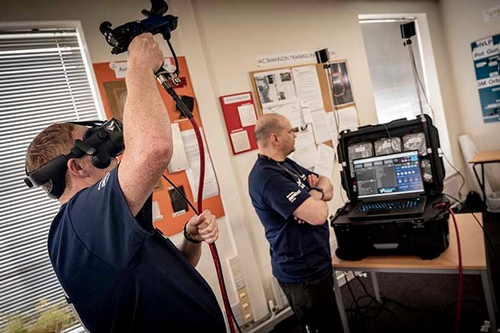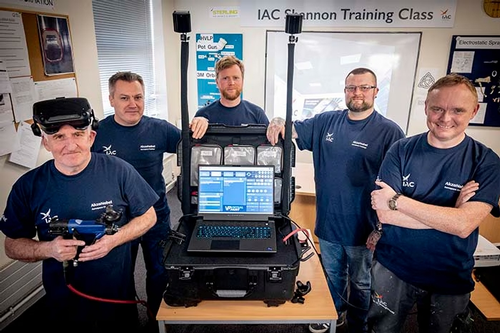TUESDAY, MAY 14, 2024
AkzoNobel Aerospace Coatings has partnered with International Aerospace Coatings to incorporate its virtual reality paint technology into the company’s future training programs.
According to AkzoNobel, global aircraft painting and aviation services IAC has now become the first maintenance, repair and operations (MRO) firm globally to use the technology in its day-to-day operations. The mobile technology has been delivered to the organization’s European headquarters as part of AkzoNobel’s Aerofleet Training+ portfolio.
About the VR Training System
Last year, AkzoNobel launched the new virtual reality training for painting aircraft at a National Business Aviation Association event. According to the release, the technology can mimic a customer’s production environment and multiple coating systems to train teams virtually and in a more sustainable and efficient way.
The VR-based system was developed by technology specialists Virtual Paint Products. It has also been successfully trialed at the company’s training center in Troy, Michigan. Since then, several portable units have reportedly been designed for use at a customer’s own premises.
AkzoNobel explains that the VR headset immerses the trainee in a virtual paint booth, with access to aircraft parts or larger-scale assemblies to the production floor itself. The system can then be programed with various paint specifications, such as the thickness of the coating required.
As the operator uses the virtual spray gun, they can reportedly see whether too much or too little paint is used and look for inconsistencies in the way the coating is being applied, the company says.

 |
| Photos: AkzoNobel Aerospace Coatings |
|
AkzoNobel Aerospace Coatings has partnered with International Aerospace Coatings to incorporate its virtual reality paint technology into the company’s future training programs. |
Through the training, the operator’s core skills, such as setting up the spraying session to the distance, angle, and speed at which the gun is used, are being measured. The feedback is reportedly immediate, allowing trainees to react quickly and change their technique.
The program will show where runs and sags occur, or where the wet film thickness is not sufficient or the coverage inadequate to deliver a smooth finish. Common paint problems such as paint overlap can also be seen, according to the company.
In February 2023, the company teamed up with American Airlines to use virtual reality technology to deliver what the company called a new way of training apprentice painters, as well as further educating existing teams.
According to the emailed release, a nose landing gear cylinder of an aircraft was programmed into the system for American Airlines. Then, a group of 13 painters of varying abilities were encouraged to spray the part—but, AkzoNobel notes, without a single drop of real paint being used.
AkzoNobel further explained that there are other benefits to the technology. For example, a painter may have been using a polyurethane paint and need to switch to a Teflon paint or use a paint with a different mix that may be heavier or lighter. This can be programmed into the system to replicate the experience in a spray booth.
Latest Partnership
The introduction of this new VR technology will reportedly enable IAC to refocus its training programs, allowing up to 70% of all new apprentice training to be completed in the classroom in the future.
John Mulqueen, Vice President Operations EMEA at IAC, said that the technology is not only relevant to new trainees, but also an essential way of further upskilling or refreshing existing painters.
 |
|
The introduction of this new VR technology will reportedly enable IAC to refocus its training programs, allowing up to 70% of all new apprentice training to be completed in the classroom in the future. |
“For new starters, it provides an immersive learning experience, while for existing staff, it offers opportunities for upskilling and career development,” he explained.
“One of the major advantages is the efficiency of the VR system, providing engaging training without material waste. Having the flexibility of access to this technology on a daily basis enhances our training programs and motivates and empowers our staff.”
The mobile nature of the VR technology also allows IAC to not only train painters at its headquarters, but also its other sites around the world.
“Being able to transfer the equipment globally helps ensure consistent training standards across all of our facilities,” John added.
“This efficiency not only benefits our training processes but also aligns with our commitment to sustainability by minimizing material usage and waste. Integrating the VR system into our training curriculum marks a significant step forward for our company in terms of safety, efficiency, and sustainability.”
Emmett Moran, Head of Operations for IAC, said that this technology will help the company upskill their existing painters and allow them to trial new primer and paint systems without the use of actual materials.
“This is a game changer from a waste perspective, as we will have zero emissions and no waste generated from this program,” he said. “We also intend to roll out a ‘Top Gun’ competition globally for our painters to see who can achieve the highest score when painting a complex component.”
“With VR as an integral part of our Aerofleet Training+ portfolio, we’re helping organisations and innovators like IAC to become significantly more efficient and sustainable in the future painting/repainting of aircraft for which they are responsible,” said Martin Carter, Area Sales Manager for UK & Ireland at AkzoNobel Aerospace Coatings.
“It’s an excellent example of a true partnership at work and demonstrates our commitment to enhancing sustainability in practical and meaningful ways.”
Tagged categories: Aerospace; aircraft; AkzoNobel; Aviation; Business management; Business matters; Business operations; Coatings; Coatings Technology; Paint application; Paint application equipment; Partnerships; Program/Project Management; Technology; Tools & Equipment; Worker training